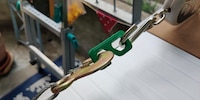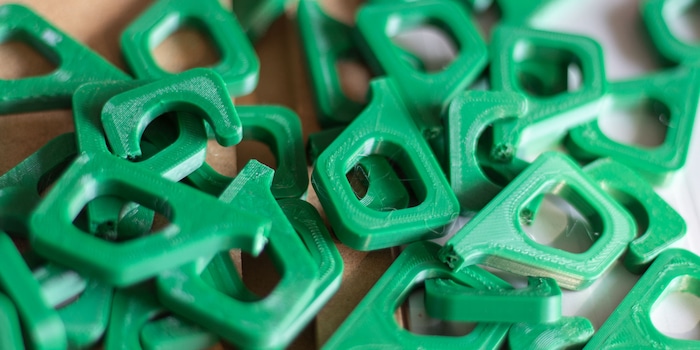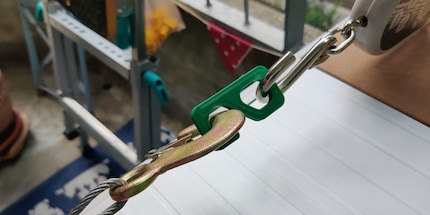
Background information
How does the wall thickness affect the thickness of your PLA prints?
by Kevin Hofer

If you want your 3D prints to look fine, choose a small layer height. If you want it to be fast, choose a large layer height. But what influence does this have on the thickness?
Should it be quick or look good? 1 hour and 49 minutes versus 3 hours and 42 minutes printing time? No printing parameter has such a blatant effect on the printing time as the layer height. Having already tested how wall thickness and infill affect the strength of PLA, I now want to find out how layer height affects it.
When I talk about strength here, I mean how much tensile force a 3D printed part can withstand. To test this, I attach a spring scale to my balcony railing. I hang the closed side of my hooks, which were 3D printed especially for this test, on the hook of the scale. I attach the cable winch to the other side. I pull on it and exert traction on my parts. As I can't "winch" and look at the display of the spring balance at the same time, I point my old GoPro at the display. This allows me to read the final result. I do the test three times and calculate the average. The whole thing looks like this:
All other parameters from the last two tests remain similar: I create three prints of the test hooks with a layer height of 0.12, 0.16, 0.2 and 0.28 millimetres. I print the hooks horizontally, 15° diagonal to the X-axis. I print slightly diagonally because I have found that the models on my Creality CR-10S Pro adhere better to the build plate this way. The other settings in Cura in English:
Printing temperature: 208° Celsius (found to be the best value for the filament in the first test)
Temperature of the printing plate: 50° Celsius
Print speed: 50 mm/s
Wall Thickness: 1.6 millimetres
Top/bottom thickness and layers: 1.12 millimetres / 4
Infill and Pattern: 50 per cent / Cubic
I do the test with the Purefill filament, which performed best in the first comparison. I get a new spool to rule out ageing processes, moisture or similar signs of wear and tear. This time I'm at home on the balcony. The temperature is 19.7° Celsius. When tested with the infill in my flat, it was between 25.7° Celsius and 26.1° Celsius and when tested with the wall thickness on the balcony, it was 20.8° Celsius.

Printing the individual models takes between 1:49 hours and 3:42 hours. After I've printed all the hooks, I leave them to cool for 24 hours and then get straight down to testing them.
| Layer height in millimetres | Print time in hours:minutes | Filament used in grams |
|---|---|---|
| 0,12 | 3:42 | 20 |
| 0,16 | 2:50 | 20 |
| 0,2 | 2:24 | 20 |
| 0,28 | 1:49 | 20 |
My test doesn't fulfil scientific criteria because I don't work in a test laboratory. Factors such as the quality of the filament also influence the test. Furthermore, this test is not aimed at professional 3D printers, but at private makers like me.
Although I print with the same parameters as last time, I achieve a poorer result with a layer height of 0.28 millimetres. In the test with the wall thickness, the filament withstood 31.7 kilograms of tensile force, a whole kilogramme difference. I can't say for sure whether this is due to the temperature, the filament or simply the test method. But I think it's down to my test method, which doesn't produce completely accurate results.
| Layer height in millimetres | Average measured tensile force in kilograms |
|---|---|
| 0,12 | 32,5 |
| 0,16 | 31,7 |
| 0,2 | 31,2 |
| 0,28 | 30,7 |
What the test does show: The layer height does have an influence on the endured tensile force. But this is small. A maximum of 1.8 kilograms difference in tensile force from 0.12 to 0.28 millimetres layer height. In my opinion, however, this does not justify the much longer printing time with a small layer height. The difference from 0.2 to 0.28 millimetres with half a kilogramme more tensile force doesn't really pay off either. The infill and the wall thickness have a greater influence.
The title of this section says it all: If you want your 3D prints to withstand as much tensile force as possible and you don't care about the appearance, you can print with a high layer thickness. The decisive factors are the wall thickness and the infill.
In the three tests, the wall thickness proved to be the biggest factor in tensile strength. User SnowBall89 has already anticipated this with a comment in the article on wall thickness:

If my prints need to withstand a lot of tensile force, I will focus on the wall thickness and then on the infill. I don't usually care about the appearance of the parts for such prints, which is probably why I choose 0.28 millimetres as the layer height.
From big data to big brother, Cyborgs to Sci-Fi. All aspects of technology and society fascinate me.